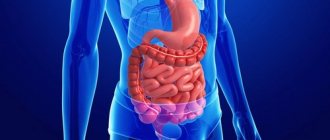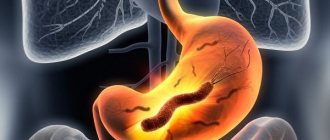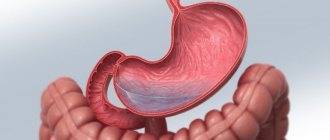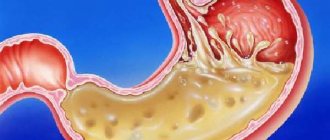Classification of gastritis
According to the mechanism of occurrence and location of the main changes in the mucous membrane, they are distinguished:
- gastritis type A - autoimmune inflammation primarily of the body of the stomach;
- gastritis type B - bacterial inflammation of the antral (outlet) part of the stomach, most often due to Helicobacter pylori infection;
- Type C gastritis is a reactive inflammation due to the reflux of bile into the stomach or the use of medications, most often non-steroidal anti-inflammatory drugs.
Mixed forms are also possible (for example, a combination of gastritis A and B).
Based on changes in the mucous membrane there are:
- non-atrophic gastritis;
- atrophic autoimmune gastritis;
- atrophic multifocal;
- special forms of gastritis: a. chemical; b. radiation; c. lymphocytic; d. granulomatous; e. eosinophilic; f. other infectious (caused by fungi, bacteria except Helicobacter, parasites); g. giant hypertrophic.
According to the state of secretion (production of hydrochloric acid and digestive enzymes), gastritis can be with preserved secretory function and with reduced secretory function.
Causes of chronic gastritis
The most common cause of chronic gastritis is Helicobacter pylori infection. Helicobaster pylori is an acid-fast bacterium that lives on the gastric mucosa. The microorganism secretes biologically active substances that protect it from the effects of acid and digestive enzymes. Acting on the mucous membrane, these substances cause inflammation. Long-term infection with H. pylori ends either in a peptic ulcer (if acid synthesis increases in response to infection), or in atrophy of the mucous membrane, metaplasia (transformation) of cells and the formation of a malignant tumor.
The next most common reason is the uncontrolled use of non-steroidal anti-inflammatory drugs (medicines for various types of pain and fever). They disrupt the restoration of mucosal cells, which makes it more susceptible to the destructive effects of hydrochloric acid.
Reflux gastritis (caused by the reflux of bile) occupies up to 15% of the pathology structure. Due to disruption of normal gastrointestinal motility, pressure in the duodenum increases. Its contents, including bile and digestive enzymes, are thrown into the stomach, damaging the mucous membrane.
Autoimmune processes can also cause gastritis. Due to a malfunction of the immune system, the body begins to perceive the cells of the gastric mucosa as foreign.
Pain and discomfort in the abdomen are the main complaints in chronic gastritis
In addition, chronic gastritis can occur against the background of severe pathology of the heart (due to insufficient supply of oxygen and nutrients to the mucous membrane, its restoration is impaired) or kidneys (due to intoxication of the body with metabolic products).
Symptoms of chronic gastritis
The severity of gastritis symptoms does not depend on the severity of changes in the mucous membrane; in many patients it is asymptomatic.
The main complaint of patients is dyspepsia: pain and heaviness in the upper abdomen, belching (air, sour, rotten), nausea. Unpleasant symptoms are clearly related to food: they occur on an empty stomach, immediately after eating, or an hour or two after eating. It depends on which part of the stomach the mucous membrane is affected.
With Helicobacter pylori infection, combined with increased acid production, stool may be disrupted, and constipation and diarrhea are possible. Frequent bowel movements are also characteristic of eosinophilic (allergic gastritis).
In addition to symptoms from the gastrointestinal tract, with chronic gastritis there are often complaints of general weakness, irritability, increased fatigue, and a tendency to low blood pressure. With a long course of the disease, signs of anemia may appear: pallor, brittle hair and nails, dizziness, tachycardia, decreased hemoglobin content in the blood. This is due to impaired absorption of iron or vitamins B12 against the background of mucosal atrophy.
Treatment
Treatment is always selected individually depending on the type of gastritis and its cause. Timely treatment can reduce symptoms, if present, and reduce the likelihood of complications.
Medicines
Drug treatment of chronic gastritis can be symptomatic or etiological - aimed at eliminating one or another cause of the disease. If H. pylori is detected in a patient with gastritis, eradication therapy is used to destroy it. In particular, the “French method” is popular today, which involves a combination of three drugs - two antibiotics plus a proton pump inhibitor. Unfortunately, it is impossible to eliminate the infection forever; after some time, the harmful microorganism again enters the body from carriers, in particular, from the patient’s relatives. Helicobacter very quickly becomes resistant to drugs, so the same antibiotics cannot be prescribed all the time.
With chemical gastritis, it is enough to eliminate its cause. For example, stopping taking medications whose side effects caused the disease. If it is not possible to refuse such a medicine, measures are taken to protect the stomach with the help of coating agents and drugs that regulate the acidity of gastric juice. The use of antacid (anti-acid) drugs helps restore damaged mucosa. It must be remembered that with the disappearance of the acid, its powerful antibacterial function disappears.
The selection of therapy for autoimmune chronic gastritis depends on the severity of inflammation. Basically, the use of medications is aimed at reducing the acidity of gastric juice. These are proton pump inhibitors, antacids and antihistamines.
Nutrition
Chronic gastritis cannot be overcome with medications alone. Radical changes are required in the patient's lifestyle, diet and diet. Therefore, already at the first appointment, the gastroenterologist necessarily recommends a certain type of diet depending on the acidity of the gastric juice: if it is low, you need acidic (berries, fruits) and juice products, if it is high, you need those that reduce the production of hydrochloric acid.
Among the products that are incompatible with the treatment of gastritis and are strictly contraindicated:
- Spices and seasonings, especially hot ones,
- Fat meat,
- Any fried food
- Smoked and canned products,
- Concentrated fruit and berry juices, especially those high in acids and sugars,
- Carbonated drinks.
Important ! It is recommended to limit the consumption of confectionery products (never on an empty stomach!), rye bread, fresh wheat pastries, strong tea and coffee.
There are quite a few approved foods for gastritis. By consuming them, you can easily create a varied and complete diet. Patients with gastritis are shown:
- Dairy products,
- Stale yeast bread,
- Lean meat, fish, soft and semi-hard cheeses,
- Soft-boiled eggs and omelet,
- Boiled cereals,
- Puree soups,
- Boiled and baked vegetables, fruits.
Diet for patients with chronic gastritis
The diet for chronic gastritis is aimed at developing favorable microflora in the gastrointestinal tract that regulates digestion and has a protective function. Meals should be fractional: regular meals 5-6 times a day. You should choose dishes that are boiled or steamed. Preferably boiled or baked meat, fermented milk products, high-fiber cereals, boiled or baked vegetables (Table 2).
The main amount of food should be consumed in the first half of the day.
It is necessary to avoid “snacks” of high-calorie foods and eating sweets on an empty stomach. Table 2. Dietary recommendations for patients with chronic gastritis.
| Gastritis with low acidity | Gastritis with high acidity |
| Healthy | |
| lean meat, fish, poultry; boiled, chopped, baked or lightly fried without breading in breadcrumbs or flour | whole milk (reduces the production of gastric juice) after meals. If the patient does not tolerate it well, you can add milk to tea |
| soups: meat, fish, mushroom, vegetable, cereal | cream, low-sour cottage cheese |
| whole milk only in dishes and drinks (porridge, cocoa), fermented milk products, cottage cheese, soft-boiled eggs, omelet | boiled, stewed, baked vegetables |
| well-cooked porridge, boiled pasta | all porridges, except millet, pasta |
| toasted white bread | lean meat, lean fish and poultry |
| non-acidic varieties of apples, pears, bananas | |
| white bread, preferably not too soft | |
| Provokes exacerbation | |
| spicy, salty, fried foods | juice products |
| canned meat and fish | strong and fatty broths - meat, fish and especially mushroom |
| soft bread and other fresh products made from yeast dough, baked goods | raw vegetables, pickles, marinades, spicy vegetable snacks, smoked meats |
| pastry, pies, brown bread | |
| ice cream, cold drinks | |
| sour juices, black bread | |
Aids
The most recommended home remedy to alleviate the disease is a decoction of chamomile. Among plants exotic to our nature, aloe juice is used as a strong anti-inflammatory agent. Oat infusion is also useful for chronic gastritis, helping to restore the affected mucous membrane. Of course, traditional methods of treatment cannot replace qualified medical care and therapy.
Gastritis in children
Children usually get gastritis at school age due to irregular and irrational nutrition; there is even a diagnosis - “school gastritis”. Treatment in this case is aimed not only at getting rid of the disease, but also at developing healthy eating habits.
Gastritis and pregnancy
Difficulties in treating gastritis in pregnant women are associated with the possible effects of the medications used on the fetus. When selecting therapy, you have to weigh the possible benefits of the medication and the harm it can cause. This primarily concerns antibiotics, many of which are strictly contraindicated during pregnancy. Proton pump inhibitors are harmful during pregnancy.
Diagnosis of chronic gastritis
Fibrogastroscopy with biopsy is necessary for the diagnosis of chronic gastritis
From the point of view of modern medicine, chronic gastritis is a morphological diagnosis. That is, it must be confirmed by the results of a histological study - studying the structure of the gastric mucosa under a microscope. Therefore, the main method for diagnosing chronic gastritis is fibrogastroscopy. With this study, the doctor can not only visually assess the condition of the gastric mucosa, recording signs of inflammation, but also take a biopsy - particles of the mucous membrane for further research.
To identify the cause of inflammation, a test is performed for Helicobacter pylori infection. To do this, they do breathing tests, or prescribe a stool test for the presence of an antigen (a complex of proteins specific to this bacterium), or a blood test for antibodies to Helicobacter pylori. One positive result is sufficient to prove infection. In order to confirm the absence of infection, two negative results obtained by different methods are needed (since none of the tests is 100% sensitive).
To rule out autoimmune gastritis, a blood test is done for antibodies to gastric parietal cells.
If for some reason it is impossible to perform a biopsy and histological examination, a gastropanel complex of biochemical studies is used to assess the condition of the stomach. To do this, determine the content in the blood of biologically active substances that are synthesized by the gastric mucosa: gastrin-17, serum pepsinogen-I and II. With atrophic changes, the content of these substances in the blood changes dramatically.
To assess the acid-forming function of the stomach, intragastric pH-metry is performed: using a special probe, the acidity level is measured.
Traditional general and biochemical blood tests for diagnosing chronic gastritis are ineffective and can only be useful for identifying anemia associated with impaired absorption of iron or vitamin B12 in atrophic gastritis.
Prevention
In order to prevent chronic gastritis, as well as to prevent relapses, it is recommended:
- timely treatment of diseases that can provoke the development of chronic gastritis;
- timely consultation with a doctor if pathology is suspected;
- balanced diet;
- regular physical activity;
- getting enough sleep at night;
- rejection of bad habits;
- avoidance of stressful situations.
Video from YouTube on the topic of the article:
Treatment of chronic gastritis
Treatment of gastritis is always complex. Patients are prescribed a diet: table No. 1 or 2 according to Pevzner (depending on the preservation of the secretory function of the stomach).
If a patient is diagnosed with Helicobacter pylori infection, he is prescribed drugs from the group of proton pump inhibitors (PPIs) and two antibacterial agents. PPIs reduce the acidity of gastric contents, making the bacterium more vulnerable, and a complex of two (and sometimes three) antibiotics is necessary, since it is extremely resistant to drug effects. Such therapy is carried out for 1-2 weeks, after which tests for Helicobacter pylori are repeated. If for some reason proton pump inhibitors cannot be recommended, drugs from the group of H2 blockers (ranitidine, famotidine) are prescribed for these purposes.
To stimulate the restoration of the mucous membrane, gastroprotectors based on rebamipide (Rebagit) are prescribed. It improves blood circulation in the mucous membrane, promotes the regeneration of its cells, and reduces the activity of inflammation. In addition, rebamipide improves the effectiveness of eradication (destruction) of Helicobacter. The drug acts throughout the gastrointestinal tract and at any of the three structural levels of the mucosa.
To reduce the feeling of heaviness and fullness of the stomach, and reduce the frequency of reflux, prokinetics (itopride) are prescribed. These drugs normalize gastrointestinal motility. For reflux gastritis, ursodeoxycholic acid preparations (ursosan) help reduce the damaging effects of bile.
What is gastritis like?
The most common form of chronic gastritis (CG) is bacterial, it occurs in almost 70% of patients. Most often it is provoked by the bacterium Helicobacter pylori (Fig. 1). Resistant to stomach acid, it is spread by the oral-fecal route. The enzymes secreted by H. pilory contribute to the destruction of the protective mucus of the stomach, which protects the tissues from the aggressive effects of gastric juice. Helicobacter is represented by various strains - from relatively harmless to extremely dangerous, causing the formation of chronic ulcers and even stomach cancer.
Figure 1. Helicobacter pylori bacterium, which causes gastritis. Micrograph using SEM. Photo: Yutaka Tsutsumi











